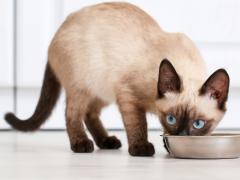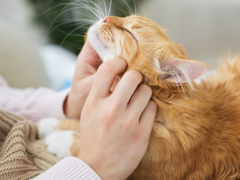
Anorexia means a loss of appetite and decreased food intake due to the loss of appetite.
Rather than being a medical condition in and of itself, anorexia in cats is a symptom that could indicate there’s an underlying medical problem that needs to be explored. Possible causes range from stress to hairballs to serious medical conditions.
Here, we’ll cover some of the most common causes and how to help a cat who isn’t eating.
What Is Anorexia in Cats?
If a cat is simply eating less (but still eating), this is called “hyporexia” or inappetence. But “anorexia” is often used as an umbrella term to describe either a decreased food intake or a total lack of food intake.
Additionally, anorexia may be further divided into “true anorexia” and “pseudo-anorexia.”
True anorexia is a loss of appetite, whereas pseudo-anorexia happens when a cat wants to eat but finds it difficult to do so (for example, if a dental problem prevents adequate chewing of food or if pain anywhere in the body distracts from mealtime).
Signs of Anorexia in Cats
Since anorexia means a loss of appetite, anorexic cats will eat less than usual or stop eating entirely. Depending on the underlying cause, anorexia may be accompanied by other signs that a cat isn’t feeling their best.
The clinical signs you see depend on the specific underlying cause and may include:
- Vomiting or diarrhea.
- Hiding or changes in mood/personality.
- Lethargy or a decrease in energy.
- Weight loss.
- Dropping food while attempting to eat.
- Drooling.
- Jaundice.
- Increased thirst and urination.
While these symptoms commonly accompany appetite loss, they’re certainly not the only possible symptoms.
Regardless of whether or not additional symptoms are present, it’s worth talking to your vet or making an appointment any time you notice an appetite change in your cat.
Causes of Anorexia in Cats
There are many, many possible causes of anorexia in cats.
Here are a few fairly common causes:
- Anything that causes an upset stomach, such as hairballs or dietary indiscretions.
- Side effects from certain medications.
- Finicky eating habits or food changes.
- Stress, for example: changes in the home, a move to a new home, boarding, or traveling.
- Intestinal parasites.
- Infections, especially upper respiratory infections that affect a cat’s ability to smell their food.
- Pain from an injury, arthritis, etc.
- Digestion issues such as IBD.
- Pancreatitis.
- Dental disease or painful teeth.
- Underlying health conditions, such as kidney disease, neurological conditions, cancer, asthma, heart conditions, etc.
Certain health conditions are more or less likely depending on a cat’s age, medical history, and symptoms.
To get to the bottom of the issue—so that anorexia can be effectively treated—a veterinarian will often recommend diagnostic tests.
Diagnostic Testing for Cats With Anorexia

True anorexia is a loss of appetite, whereas pseudo-anorexia happens when a cat wants to eat but finds it difficult to do so
To determine the cause of anorexia, a veterinarian will use all information available, including a cat’s medical history and symptoms.
Try to observe and gather as much information as you can while waiting for your veterinary appointment. For example, note how long anorexia has been going on, whether your cat is still eating small amounts (and if they are only eating certain foods), if anorexia is getting worse or accompanied by other symptoms of illness, anything unusual your cat could have gotten into, and whether your cat goes outside.
During the visit, your veterinarian will perform a physical examination to evaluate overall health and look for any abnormalities such as a fever, tooth problems, an abdominal mass, weight loss, etc.
Often, diagnostic tests are needed to provide more information and reach a diagnosis. This may include:
- A fecal exam to check for parasites.
- Bloodwork to evaluate organ function, blood sugar, electrolyte balance, and (if indicated) hormone tests, tests for infectious diseases, or other blood tests.
- Urine analysis.
- Blood pressure.
- X-rays or an ultrasound to take a closer look at a cat’s digestive tract.
- Endoscopy or biopsies.
Prognosis for Cats Who Aren’t Eating
For example, an otherwise-healthy cat with parasites could be completely cured and ready to eat again with a simple parasite treatment. On the other hand, a cat whose inappetence is due to cancer likely has a much poorer prognosis for returning to normal health and eating habits.
So the most important thing is figuring out why a cat isn’t eating. That information will determine prognosis and treatment.
Anorexia May Carry Risks or Complicate Underlying Health Problems
Regardless of the cause, prolonged or severe anorexia may result in complications that lead to a worse prognosis.
A common scenario is a cat developing hepatic lipidosis or fatty liver. This occurs when the liver is overwhelmed by the need to rapidly process stored body fat into energy when a cat isn’t eating, and it can cause liver failure.
Treatment often takes several weeks, and the condition can be fatal. Fatty liver can develop surprisingly quickly, especially in overweight cats who may get the condition after just a couple of days of not eating.
Good nutrition is also important for supporting healthy immune system function and helping a cat heal from whatever medical condition caused anorexia in the first place.
So it’s important to get a cat eating again as quickly as possible.
How To Treat Anorexia in Cats

The treatment of anorexia in cats will differ depending on its underlying cause.
Treatment is primarily addressed at the underlying cause and varies greatly depending on an individual cat’s needs (for example, heart medications for a heart condition, or a prescription diet for digestion issues).
Also, regardless of underlying cause, supportive care should be implemented until a cat’s appetite returns, to prevent complications and the risk of fatty liver.
Here are some of the most common supportive care efforts that may help an anorexic cat:
- Antiemetic (anti-nausea/anti-vomiting) medications.
- Pain medications.
- Anti-inflammatories.
- Appetite stimulants.
- Fluid and electrolyte support (which may be administered under the skin or via an IV catheter at the vet’s office).
- Tempting foods to encourage appetite, such as canned foods with a strong odor, your cat’s favorite treat, tuna fish, or plain baked or boiled chicken.
- Measures to decrease stress as much as possible. Feed your cat in a quiet place in the home, preferably away from other pets who may be in competition for food.
- Hand feeding while providing extra attention or praise.
- Warming a cat’s food before serving them. Just check that the food is not too hot (no warmer than body temperature), especially if using a microwave which may create hot pockets.
- Force feeding or syringe feeding a cat. This method may work if the cat accepts food this way, or if nutritional support is only needed for a short time. However, if a cat resists force feeding (which is common), this method can cause food aversion and make anorexia worse.
- If indicated, hospitalization and feeding tube placement. This may sound a little scary, but for cats who need nutritional support for an extended period of time, a feeding tube is actually more comfortable and much less stressful than force feeding.
Some of these measures can be tried at home, but others (such as prescription-only medications) must be used under a veterinarian’s guidance.
Conclusion
Anorexia, or decreased appetite, has many possible causes in cats ranging from stress to minor medical conditions to serious or life-threatening medical conditions. Any time a change in appetite is noticed, it’s best to schedule a veterinary consult and get to the bottom of the issue (and provide appropriate treatment) sooner rather than later.
Frequently Asked Questions
How is anorexia treated in cats?
Treatment is directed at the underlying cause of the anorexia. That helps ensure the anorexia will truly be cured (or managed as well as possible over the long-term, for chronic conditions).
Supportive care is also needed to prevent complications of anorexia until a cat is eating normally again, and may include medications, fluid support, tempting foods, or feeding by hand.
What can cause anorexia in cats?
Many different things may lead to anorexia in cats. Causes range from curable conditions (for example, parasite treatment or extraction of a painful tooth) to serious health conditions that may be life-threatening (for example, certain cancers). Even emotional factors such as stress may cause anorexia.
What is the best appetite stimulant for cats?
Mirtazapine (an anti-depressant medication that also has anti-nausea effects) and Cyproheptadine (a type of antihistamine) are the two most commonly prescribed appetite stimulants in cats. These medications should be used under the guidance of a veterinarian.
How do you know if a cat is starving?
One sign of starvation is a cat’s appearance—for example, if the shapes of the ribs, hips, and spine can be easily seen under the skin, a cat is probably underweight. Cats who aren’t getting enough nutrition and calories may also have less energy.
Veterinary care should be sought as soon as an appetite change is noted, well before any suspicion of starvation.







